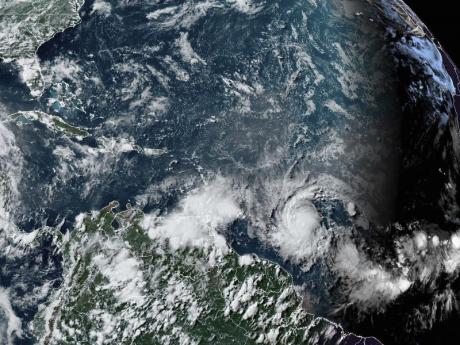Hurricane Beryl forecast to become a Category 4 storm as it nears southeast Caribbean
SAN JUAN, Puerto Rico (AP) — Hurricane Beryl is forecast to strengthen into a powerful Category 4 storm as it approaches the southeast Caribbean, which began shutting down Sunday amid urgent pleas from government officials for people to take shelter.
Hurricane warnings were in effect for Barbados, St Lucia, Grenada, and St Vincent and the Grenadines.
Beryl's centre is expected to pass about 70 miles (112 kilometres) south of Barbados on Monday morning, said Sabu Best, director of Barbados' meteorological service.
"This is a very serious situation developing for the Windward Islands," warned the National Hurricane Center in Miami, which said that Beryl was "forecast to bring life-threatening winds and storm surge."
Beryl was located about 335 miles (570 kilometres) east-southeast of Barbados. It was a Category 3 storm with maximum sustained winds of 120 mph (195 kph) that was moving west at 21 mph (33 kph). It is a compact storm, with hurricane-force winds extending 15 miles (30 kilometres) from its centre.
Beryl is expected to pass just south of Barbados early Monday and then head into the Caribbean Sea as a major hurricane on a path toward Jamaica. It is expected to weaken by midweek, but still remain a hurricane as it heads toward Mexico.
Beryl strengthened into a Category 3 hurricane on Sunday morning, becoming the first major hurricane east of the Lesser Antilles on record for June, according to Philip Klotzbach, Colorado State University hurricane researcher.
It took Beryl only 42 hours to strengthen from a tropical depression to a major hurricane — a feat accomplished only six other times in Atlantic hurricane history, and with September 1 as the earliest date, according to hurricane expert Sam Lillo.
Beryl is now only the third Category 3 hurricane ever recorded in the Atlantic in June, following Audrey in 1957 and Alma in 1966, hurricane specialist and storm surge expert Michael Lowry said.
"Beryl is an extremely dangerous and rare hurricane for this time of year in this area," he said in a phone interview. "Unusual is an understatement. Beryl is already a historic hurricane and it hasn't struck yet."
Hurricane Ivan in 2004 was the last strongest hurricane to hit the southeast Caribbean, causing catastrophic damage in Grenada as a Category 3 storm.
"So this is a serious threat, a very serious threat," Lowry said of Beryl.
Reecia Marshall, who lives in Grenada, was working a Sunday shift at a local hotel, preparing guests and urging them to stay away from windows as she stored enough food and water for everyone.
She said she was a child when Hurricane Ivan struck, and that she doesn't fear Beryl.
"I know it's part of nature. I'm OK with it," she said. "We just have to live with it."
Forecasters warned of a life-threatening storm surge of up to 9 feet (3 meters) in areas where Beryl will make landfall, with up to 6 inches (15 centimetres) of rain for Barbados and nearby islands.
Long lines formed at gas stations and grocery stores in Barbados and other islands as people rushed to prepare for a storm that has broken records and rapidly intensified from a tropical storm with 35 mph (56 kph) winds on Friday to a Category 1 hurricane on Saturday.
Warm waters were fuelling Beryl, with ocean heat content in the deep Atlantic the highest on record for this time of year, according to Brian McNoldy, University of Miami tropical meteorology researcher. Lowry said the waters are now warmer than they would be at the peak of the hurricane season in September.
Beryl is the second named storm in what is forecast to be an above-average hurricane season, which runs from June 1 to Nov. 30 in the Atlantic. Earlier this month, Tropical Storm Alberto came ashore in northeastern Mexico with heavy rains that resulted in four deaths.
The National Oceanic and Atmospheric Administration predicts the 2024 hurricane season is likely to be well above average, with between 17 and 25 named storms. The forecast calls for as many as 13 hurricanes and four major hurricanes.
An average Atlantic hurricane season produces 14 named storms, seven of them hurricanes and three major hurricanes.
Follow The Gleaner on X and Instagram @JamaicaGleaner and on Facebook @GleanerJamaica. Send us a message on WhatsApp at 1-876-499-0169 or email us at onlinefeedback@gleanerjm.com or editors@gleanerjm.com.

